As one of the most important sporting events in the world, the FIFA World Cup in Qatar had over 5.4 billion viewers. Since the announcement of the Qatar World Cup in December 2010, construction and preparation commenced to make the first FIFA World Cup in the Middle East possible. Immigrants from India and Africa built stadiums, secured safety of the games, and provided service, acting as a crucial factor that allowed the World Cup to take place. A total of two million migrant workers helped to facilitate the process, but among them, over 6,500 people have died due to poor living and working conditions, highlighting the underlying problem behind the World Cup and exposing the larger topic of worker abuse. The FIFA World Cup was not the first example of abuse of migrant workers as the root of the problem can be traced back to the last century.
A significant factor contributing to workers’ abuse in Qatar is the Kafala System, or the Sponsorship System. Originally adopted in the 1950s, this system legally binds foreign workers to their employers, leaving the workers prone to manipulation and without the ability to escape such abuse. While the system was originally created to enhance regulation between employers and migrant workers, this policy now only takes away migrant workers’ freedom and makes them dependent on their employers. For instance, employers were responsible for renewing migrant workers’ resident permits, which the workers themselves had no control over. However, when the permits failed to be renewed, the workers then became the victims that had to bear the consequences themselves. Furthermore, the employers also had the power to cancel workers’ permits, demonstrating the power disparity which dismisses the laborer’s human rights and causes the workers to be stuck in a cycle of abuse. Furthermore, other prohibitions such as passport confiscation prevent workers from leaving the country, adding onto the problem. The lack of labor unions and labor laws in the society also shows problematic judicial and legislative practices that are hostile to migrant workers. Collectively, the system in Qatar made the migrant workers prone to labor exploitation, leaving them vulnerable during the FIFA World Cup.
During the construction of the stadiums, the two largest problems the workers faced were wage delay and injustice. Amnesty International revealed that 100 employees of Qatar Meta Coats were not paid any wages for as long as seven months. In response to this, FIFA stated that they were unaware of this issue, implying that they failed to take cases of human rights abuses linked to the World Cup seriously. Moreover, even when workers were paid wages, the amount they received was extremely minimal. Ironically, while Qatar had spent nearly $220 billion on new infrastructure for the World Cup, they had kept labor costs low for the migrant workers. In addition to low wages, migrant workers in Qatar received lack of proper recognition for their deaths, and the true causes of their deaths were hidden by the responsible committees. In fact, while there have been 37 deaths that were directly linked to construction of World Cup stadiums, 34 of them were classified as “non-work related”. In many other examples, the deaths were covered up as “natural death” in order to conceal the workers’ abuse.
Regarding this issue, ongoing protests and public reforms were also important in dictating the prospect of migrant workers’ future. In 2017, the Qatar government signed an agreement with the International Labor Organization (ILO) to prevent labor exploitation and adhere labor practices to the international standards. This marks a sign for positive change, but it will not be effective until it is properly enforced. However, in many cases, weak implementation limits the impact of beneficial legislation to the workers. For instance, the Workers’ Welfare Standards provides restrictions on worker abuse and was meant to protect the workers under abuse, nevertheless examples of exploitation remained prevalent. Targeting the sponsorship system, the country ended the exit permit requirement in 2018 and allowed the workers to have the freedom to leave. Overall, many advancements have been made to improve the workers’ access to justice, health and safety, and wages, but in order to maintain a positive trend, there needs to be increased monitoring and detection of abuse. It is necessary for companies to respect the human rights of all workers equally for the abuse of migrant workers to one day come to an end.
Sources:
26, December. “BeIN Sports Announces Record-Breaking Cumulative Viewership of 5.4 Billion for FIFA World Cup Qatar 2022TM.” BeIN SPORTS, 26 Dec. 2022, https://www.beinsports.com/en/fifa-world-cup-qatar-2022/news/bein-sports-announces-record-breaking-cumulat/2011581.
“Profile of the FIFA World Cup Qatar 2022™.” FIFA Publications, https://publications.fifa.com/en/sustainability-report/sustainability-at-the-fifa-world-cup/profile-of-the-fifa-world-cup-qatar-2022/.
“Reality Check: Migrant Workers’ Rights in Qatar.” Amnesty International, 20 Oct. 2022, https://www.amnesty.org/en/latest/campaigns/2019/02/reality-check-migrant-workers-rights-with-two-years-to-qatar-2022-world-cup/.
“Revealed: 6,500 Migrant Workers Have Died in Qatar since World Cup Awarded.” The Guardian, Guardian News and Media, 23 Feb. 2021, https://www.theguardian.com/global-development/2021/feb/23/revealed-migrant-worker-deaths-qatar-fifa-world-cup-2022.
“Op-Ed: The Kafala Sponsorship System Fuels Modern Day Slavery.” Ed, https://sites.bu.edu/pardeeatlas/opinions/op-ed-the-kafala-sponsorship-system-fuels-modern-day-slavery.
Ward, Ian. “The Many, Many Controversies Surrounding the 2022 World Cup, Explained.” Vox, Vox, 19 Nov. 2022, https://www.vox.com/world/23450515/world-cup-fifa-qatar-2022-controversy-scandals-explained.
Written by Annie Zhu
Edited by: Shiksha Anand

 Qatar’s Recycleble Soccer Stadium
Qatar’s Recycleble Soccer Stadium